AMD’s 5 GHz Turbo CPU in Retail: The FX-9590 and ASRock 990FX Extreme9 Review
by Ian Cutress on August 9, 2014 8:00 AM ESTGaming Benchmarks
F1 2013
First up is F1 2013 by Codemasters. I am a big Formula 1 fan in my spare time, and nothing makes me happier than carving up the field in a Caterham, waving to the Red Bulls as I drive by (because I play on easy and take shortcuts). F1 2013 uses the EGO Engine, and like other Codemasters games ends up being very playable on old hardware quite easily. In order to beef up the benchmark a bit, we devised the following scenario for the benchmark mode: one lap of Spa-Francorchamps in the heavy wet, the benchmark follows Jenson Button in the McLaren who starts on the grid in 22nd place, with the field made up of 11 Williams cars, 5 Marussia and 5 Caterham in that order. This puts emphasis on the CPU to handle the AI in the wet, and allows for a good amount of overtaking during the automated benchmark. We test at 1920x1080 on Ultra graphical settings.
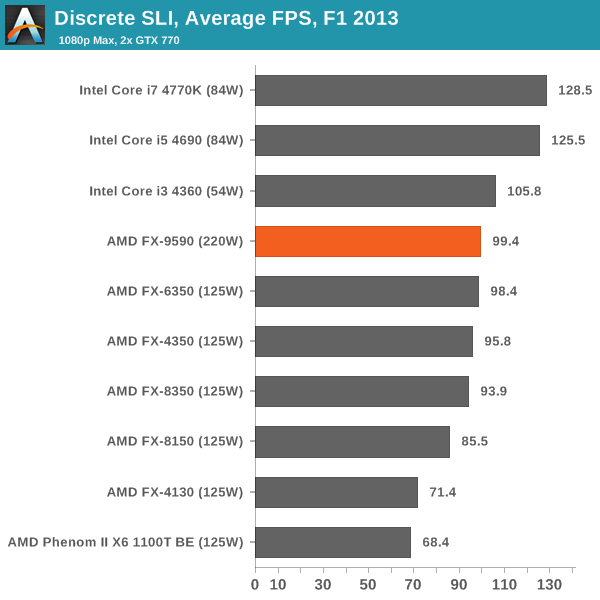
The FX-9590 seems to match the i3-4360, indicating that even more cores, more frequency and more PCIe lanes is not always a good thing. The i3-4360 is using PCIe 3.0 x8/x8, compared to PCIe 2.0 x16/x16 for the FX-9590, which should put them both equal in bandwidth.
Bioshock Infinite
Bioshock Infinite was Zero Punctuation’s Game of the Year for 2013, uses the Unreal Engine 3, and is designed to scale with both cores and graphical prowess. We test the benchmark using the Adrenaline benchmark tool and the Xtreme (1920x1080, Maximum) performance setting, noting down the average frame rates and the minimum frame rates.
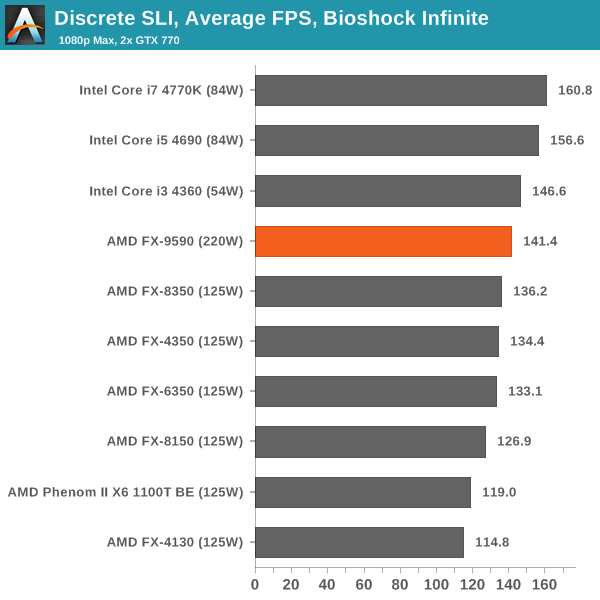
Again, the FX-9590 is trading around the Haswell i3 margin.
Tomb Raider
The next benchmark in our test is Tomb Raider. Tomb Raider is an AMD optimized game, lauded for its use of TressFX creating dynamic hair to increase the immersion in game. Tomb Raider uses a modified version of the Crystal Engine, and enjoys raw horsepower. We test the benchmark using the Adrenaline benchmark tool and the Xtreme (1920x1080, Maximum) performance setting, noting down the average frame rates and the minimum frame rates.
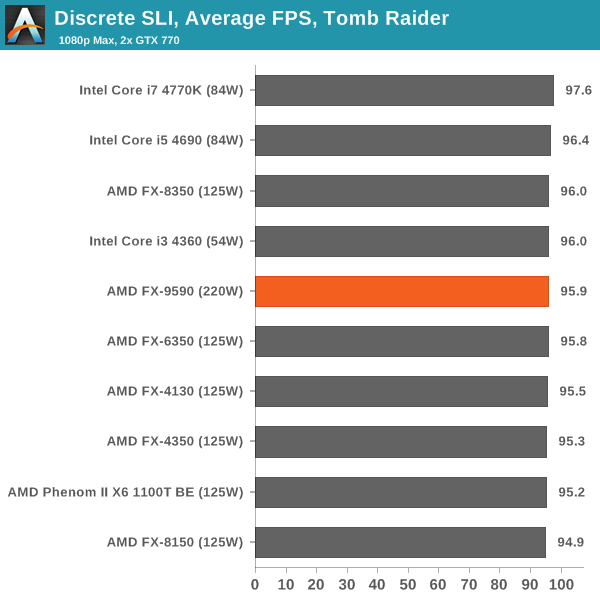
Tomb Raider has historically been CPU agnostic, with all the latest CPUs performing similarly.
Sleeping Dogs
Sleeping Dogs is a benchmarking wet dream – a highly complex benchmark that can bring the toughest setup and high resolutions down into single figures. Having an extreme SSAO setting can do that, but at the right settings Sleeping Dogs is highly playable and enjoyable. We run the basic benchmark program laid out in the Adrenaline benchmark tool, and the Xtreme (1920x1080, Maximum) performance setting, noting down the average frame rates and the minimum frame rates.
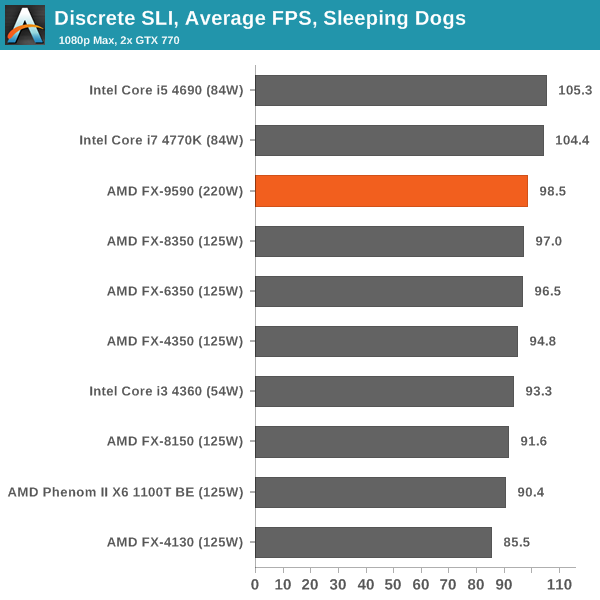
The FX-9590 loses 4-6 FPS on average to the latest Intel cohort, which is not bad considering the release date difference.
Company of Heroes 2
Company of Heroes 2 also can bring a top end GPU to its knees, even at very basic benchmark settings. To get an average 30 FPS using a normal GPU is a challenge, let alone a minimum frame rate of 30 FPS. For this benchmark I use modified versions of Ryan’s batch files at 1920x1080 on High. COH2 is a little odd in that it does not scale with more GPUs with the drivers we use.
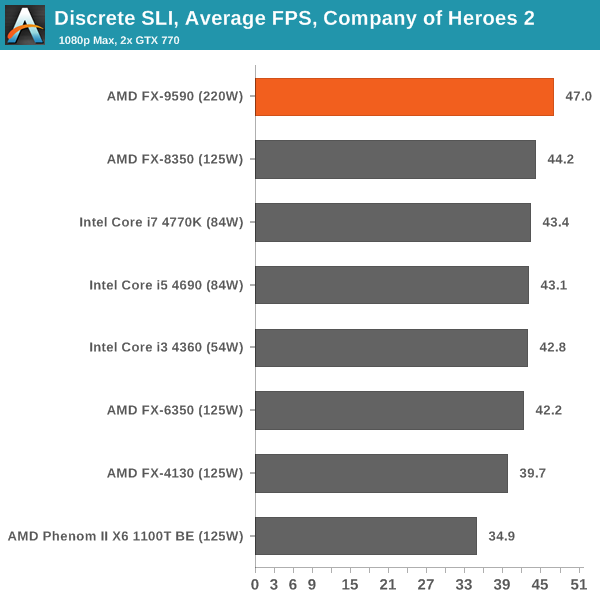
Company of Heroes 2 is usually relatively CPU agnostic except for the older dual core CPUs, but the FX-9590 gets a win here.
Battlefield 4
The EA/DICE series that has taken countless hours of my life away is back for another iteration, using the Frostbite 3 engine. AMD is also piling its resources into BF4 with the new Mantle API for developers, designed to cut the time required for the CPU to dispatch commands to the graphical sub-system. For our test we use the in-game benchmarking tools and record the frame time for the first ~70 seconds of the Tashgar single player mission, which is an on-rails generation of and rendering of objects and textures. We test at 1920x1080 at Ultra settings.
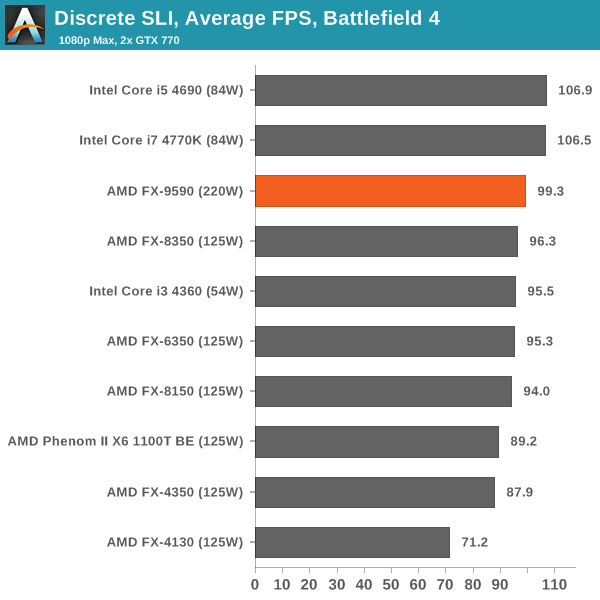
Similar to Sleeping Dogs, the FX-9590 does not lose much considering the release date difference of the architectures.






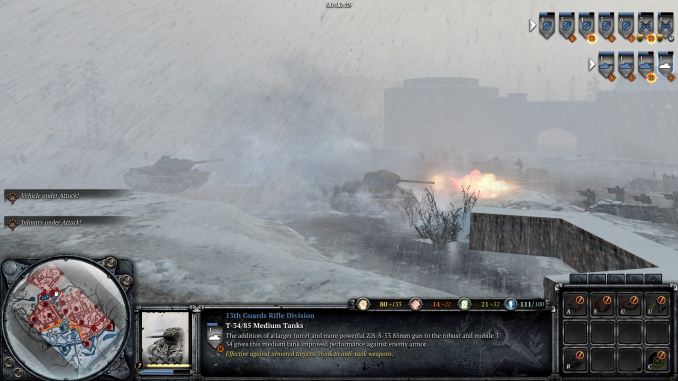









146 Comments
View All Comments
thejshep - Sunday, August 10, 2014 - link
But even if you more than double the wattage of an i7, you're still not approaching the wattage this cpu takesSkillztech - Friday, September 12, 2014 - link
Cause it is totally intel biasedSkillztech - Friday, September 12, 2014 - link
No need to over clock this chip at all, totally powerful. intel and the low voltage low power chips just suck at the same price range.TiGr1982 - Saturday, August 9, 2014 - link
This FX-9590 is actually the last year's product. E.g., in Canadian Canada Computers this SKU (in the version without any cooler) lays on the shelves for months and almost nobody buys it. At the same time, they have a big turnaround of Haswell Intel i7's, which speaks for itself."Re-release" of this SKU happens because AMD has nothing better to offer, so they hope to get some public attention which it better than zero public attention :)
I'm not an old man (age 32 now), but I remember the times (2005) when even Alienware top laptops were based on AMD Turions (rebranded Athlons 64) - simply because these were better than Intel's Pentium M at the time.
And, in contrast, in around last three years since Bulldozer release AMD CPU business looks poorly.
Yes, I know, APUs, OpenCL, HSA. But the CPU side of things at AMD is sad.
Da W - Monday, August 11, 2014 - link
AMD should just drop Bulldozer. That's probably what they're doing.Skillztech - Friday, September 12, 2014 - link
8 cores high multi tasking and usage with high end core hungry software leaving intel in the dust. Plus the ability to game awesome. A real CPU.Budburnicus - Saturday, January 10, 2015 - link
Intel's i7-2600K SPANKS this POS in every conceivable way! AND it is THREE years old! This is even at stock clocks, just TRY comparing this CPU in any overclock to an i7-2600K at 4.4 Ghz (and overclock that basically ANY 2600K can handle - I have mine at 4.7 and 102.3 Bclock)And with EVERY benchmark available - the 4.4 Ghz OC,ed i7-2600K will COMPLETELY blow this POS out of the water! (BTW Not only is 4.4 easy to hit, but the TDP never goes above 125 - even with my 4.7 OC, as stock TDP is only 95w!)
I USED to be an AMD "Fanboy" back in the days of Intel's Pentium 4 "Net Burst" architectural FLOP! And the Athlon XP' superior gaming performance and performance per dollar - with better overclocking!
But since PileDriver FIRST came out, I have only shuddered at the thought of this architecture even existing, let alone being pushed farther and farther! Intel KNEW Net Burst was horrible, and dumped it ASAP for first Core and then Core2 architectures - which were very competitive in all ways for their day.
On the eve of SandyBridge, once benchmarks became available it was OBVIOUS that the SandyBridge Architecture was game changing, especially since the about $350 (at release) i7-2600k - and even the $250 i5-2500K completely SPANKED even Intel's own i7-900X extreme edition CPUs whicbh cost about $1000!
Ever since AMD swallowed ATI it seems they really dropped the ball (in both courts!) Continuing this HIGHLY inefficient chip design - which is ACTUALLY only a Quad core - with just 2x the ALU's per core serving as a full "dual core" processing unit - they left out MANY components that make up a FULL core, and most importantly, while L2 cache is slightly larget than Intel's chips for the most part, the caches are MUCH slower! And a "Dual Core Unit" has twice the ALUs vying for L2 access, where L3 cache is INCREDIBLY slow at something like 200 GB/sec to ALL cores - where Intel's i7-2600K has 168 GB/sec DEDICATED PER CORE! And that is at stock speeds too!
So you have REALLY got to ask yourself, when a 3 year old Intel part - which by now is not only cheaper - but FAR more power efficient, is MUCH faster, at stock clock, than a BRAND new AMD part - which takes well over twice the power and puts out over twice the heat, WTF is th point in buying AMD?
Especially when one considers that on a CHEAP Z68 or Z77 chipset board - this three year old i7-2600K can EASILY hit 4.4 Ghz - and it will STILL be more power efficient than the AMD part - as well as multitudes faster in EVERY way that truly matters - this just seem sad for AMD...
They are eating more power, and crapping less performance - even per $! Unless you really want a bargain basement gaming PC - then an A10 APU with a cheap GFX card will be cheaper than an Intel build with similar performance (but we are talking $500 and less for a entirely new build!)
So this FX just represents a sad bit of AMD history, sure the hardcore "fan-boys" will cling tightly to their AMD parts they have invested money into - but (and there is always that BUT) everything about this new FX chip is far behind, and the ONLY reason one should even consider purchasing one is if they already own a good Socket AM3+ mobo - for new builds? AVOID AMD FX CHIPS LIKE THE PLAGUE!
SlowSpyder - Saturday, August 9, 2014 - link
For those who are running their CPU's at 100% load 24 hours a day, seven days a week, 365 days a year, this isn't the right CPU. That's likely a quite small population of people. There are cons to the FX 9xxx CPU's to be sure, but I don't think what are often over-blown energy usage costs are one of them.MatthiasP - Saturday, August 9, 2014 - link
The real problem is, there is not a single pro for this processor.SlowSpyder - Saturday, August 9, 2014 - link
For someone looking to build a new system, probably not a lot of pros. For AM3+ owners looking for an upgrade from a lower part and guaranteed clocks, there could be some value in this processor.